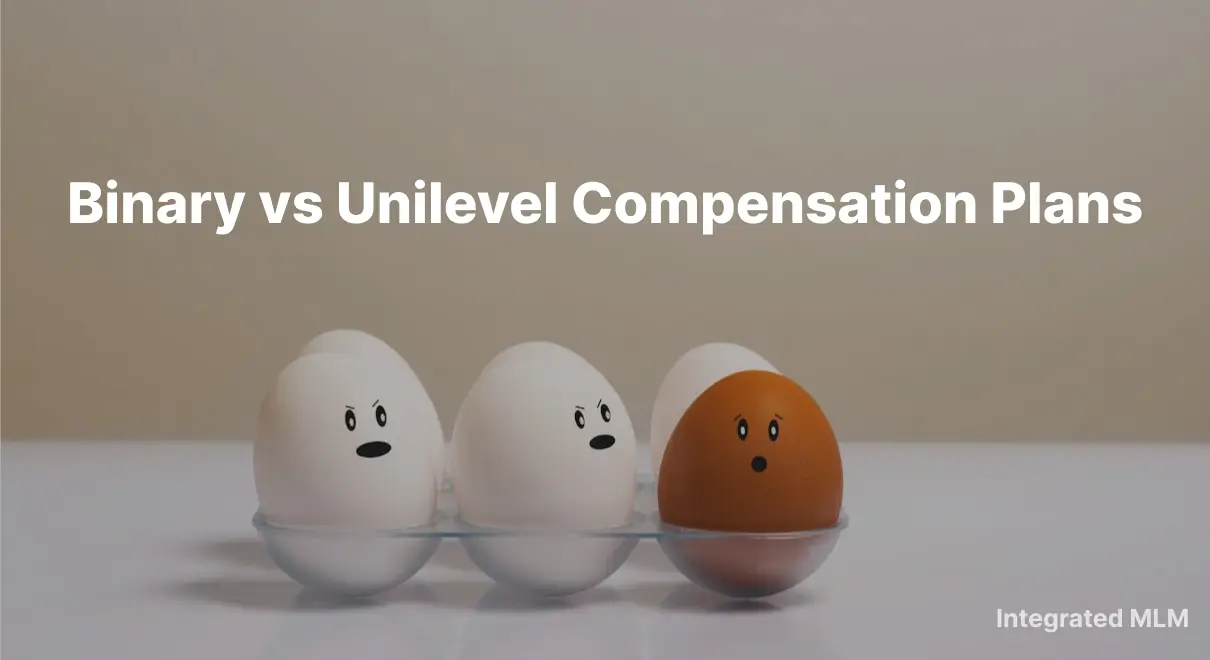When comparing compensation models, the Unilevel vs Binary Compensation Plan debate stands at the heart of strategic decision-making for MLM companies. A company’s payout plan is not just a tool for compensating distributors but a core element that shapes behavior, drives performance, and ultimately fosters the company’s growth.
By aligning individual efforts with organizational goals, compensation plans serve as a catalyst for company expansion.Therefore, it is essential for companies to carefully select the most appropriate compensation plan.
Among the various payout plans available, the Unilevel and Binary Compensation Plans are the most sought-after due to their simplicity and structure. Each comes with its own unique advantages and potential drawbacks.
This blog will guide you through everything you need to know about these two popular options to give you a better grip over the most suitable option for you.
Table of Contents
Unilevel MLM Compensation Plan
In one word, Unilevel Compensation Plan is one of the simplest and most straightforward plans available in the MLM field. True to its name, the plan allows an unlimited number of members to be distributed on the immediate downline of a distributor.
They earn from direct sales, direct recruitment and also incentives from the efforts of their downline. The commissions accrued from the downline reduces as the depth gets steeper.

Key features
- Unlimited Width: There is no limit in the number of direct recruits that can be deployed under a single distributor in a Unilevel Plan.
- Linear Structure: All distributors have one level beneath them.
- Commissions: The calculations are straight, simple and easy based on sales percentage.
Binary MLM Compensation Plan
A binary Compensation Plan is based on binary structure which means each distributor gets to recruit only two frontline members. One member is called the left leg and the other will be the right leg. If the distributor has additional recruits, they are called spillovers and are placed below their direct recruits. This is called the ‘spillover effect’.
The compensations are based on the sales volume of the weaker leg. Hence, the most important job of a distributor when it comes to recruitment efforts is to balance the efforts of both their legs.

Key Features:
- Two leg structure: Each distributor has only two direct recruits in a Binary MLM Plan.
- Spillover: Additional recruits are placed under the downline of direct recruits.
- Balance: Keeping both legs balanced is crucial to attain a balanced income in a Binary Plan as the compensation is based on the weaker leg.
Comparing Unilevel vs Binary MLM Compensation Plans
Both these plans can be compared based on their structure, earning potential and complexity:
Structure
Unilevel compensation plan allows unlimited number of direct recruits whereas binary compensation plan allows only two direct recruits. Hence in a unilevel plan, the distributor is in charge of the recruitment and sales effort he is willing to take whereas in the Binary Compensation Plan, it has already been laid out.
Any additional recruitment efforts goes to the downline members, building team spirit and mutual cooperation.
Spillover Effect
In unilevel plan, a recruiter is free to add as many members to their immediate downline and hence experiences no spillover effect. The commission is a direct result of their own recruitment efforts.
However, in Binary MLM, the additional recruitment efforts benefit downline members offering further motivation and support from the upline members.
Commission Strategy
Unilevel plan has a simpler commission calculation based on percentage of sales efforts from the downline.
Binary plans have a more complex system where the members earn based on the performance of their weaker leg. Hence balancing both legs for an equal intensity of growth is crucial to earn consistently.
Pros and Cons of Unilevel and Binary Plans
Pros of Unilevel Plan:
- Simplicity:
- An MLM Unilevel Plan is easy to understand and straightforward. This makes it easy for distributors to understand. The organizational placement of an unlimited number of direct recruits and compensation based on a simple percentage of sales can be grasped by the new recruits in their journey forward.
- Transparency:
- Unilevel plans have an innate transparency enabling distributors to understand how much each downline is contributing to the earnings. This helps them manage their downline efficiently by formulating strategic efforts.
- Unlimited Earning Potential:
- Due to lack of a limit on the number of direct recruits, the Unilevel Compensation Plan comes with the boon of unlimited potential as well. Each new recruit contributes directly to the distributor earnings.
- Scalability:
- The Unilevel Compensation Plan is also unique in its ability to facilitate scalability. By supporting broad recruitment, there is rapid expansion of network width.
Cons of Unilevel Plan:
- Haphazard Growth:
- With no limits on the number of direct recruits in the direct downline, there is a chance of potential unlimited, unattended growth. This may result in diminishing returns especially when depth of levels increase. Which means, despite higher recruitment efforts, there can be no significant earnings.
- Limited Depth Incentive:
- Since the distributors are focused on direct downline recruitment and don’t contribute much towards recruitment efforts of downline members, the incentives that come from the downline are also limited.
- Lack of Support:
- Since there is no spillover effect like the MLM Unilevel Plan, weaker recruits might struggle to keep up with the growth based solely on individual efforts.
Pros of Binary Plan:
- Teamwork:
- Binary structure which has limited direct recruits, enables the distributors to be more conscious of the downline activity and contribute to their growth thereof. They can offer support and collaboration to ensure both legs are growing even.
- Balanced Development:
- The growth is not only under control but also sustainable and balanced. It is ensured that there are no dormant and inefficient nodes in the downline as weak spots may affect the balance as well as the incentives. This vigilance from the upline members ensures that the structure stays and grows efficiently.
- Spillover effect:
- The weaker legs or members are directly supported by their upline members. This fosters trust, support and an air of commitment within the team reducing the struggle that occurs to the new recruits.
- Incentive for Upline:
- The spillover not only supports the downline members but also incentivizes the upline members enhancing the overall performance of the team.
Cons of Binary Plan:
- Complex:
- The Binary MLM Plan is not only complex in calculations but also to understand. The optimal earnings are calculated based on the weaker leg’s performance. Hence the distributor may struggle to manage the growth between both the power leg and the weaker leg.
- Pressure:
- The distributors are pressured to balance both legs mandatorily as their incentives and earnings depend on it. Unlike the unilevel MLM plan where the lion’s share of earning comes from direct recruits, for MLM Binary plan, the downline plays a crucial role.
- Risk of Imbalance:
- In cases where distributors are unable to fully capitalize the efforts of weaker leg, this can lead to discouraging the efforts of the stronger leg. The complexity of the payout plan too may discourage the members from putting in efforts.
Choosing Between Unilevel and Binary Plans
To circle down between the unilevel and binary, various factors such as the business goals, recruitment strategy and complexity of the payout plans must be considered.
Unilevel Compensation Plan is ideal for the teams who have a lot of industrial experience and those who can manage the chaos of unlimited growth. If well managed, the Unilevel structure can bless the venture with great returns.
Binary Compensation Plan suits the teams who prefer more of a structured and controllable growth. They are more suited for ventures who are trying to find their feet in the industry. The plan fosters team spirit and an environment of lesser risk.
Factors for Choosing Unilevel or Binary Plans
If you are still struggling to choose between these two stunners, ask yourself the following questions to feel where it rings the right bell.
- Recruitment Strategy:
- What recruitment strategy would your firm be best accustomed to? Would it prefer a broad, direct and rapidly growing recruitment strategy or a controlled, deep and cohesive pathway?
- Commission Preferences:
- Would you like to stick to an easy, self-explanatory and easily adaptable compensation plan or would you choose to adapt a complex, manageable and rather elusive payout calculation?
- Support System:
- Do you have a team with experience enough to grow themselves to the beat of organizational growth? Or do you have diamonds in the rough who require support of the upline members?
Conclusion
Unilevel compensation plan and Binary compensation plan are undoubtedly two of the most sought after MLM Compensation plans. Companies such as Young Living, doTERRA and Mary Kay have got the best of Unilevel MLM Plan and Herbalife, Amway and USANA have hacked the Binary MLM plan.
These companies have tailored their compensation plans to align with their business models and motives. Along the same lines, based on a thorough understanding of the requirements and abilities of your multi-level-marketing business, you can zero down on your compensation plan amongst these two.
Frequently Asked Questions
-
Switching from a Unilevel to a Binary Compensation Plan: Is It Possible?
This depends on the MLM company’s policy and is evaluated on a case-by-case basis. Some companies allow switching between plans, while others do not.
In some cases, companies implement both compensation plans, known as a hybrid MLM plan.
-
Which plan offers higher earning potential?
Based on the sales and recruitment strategies, both compensation plans can earn rewardingly, as discussed in our blog on how to make money in mlm
-
Is the MLM Binary plan more complex than the MLM Unilevel plan?
Unilevel MLM Plan is undoubtedly more straightforward than a Binary MLM Plan. The complexity lies in the effort to balance both legs.
-
Can spillover be a disadvantage in a Binary plan?
If not strategically balanced, spillover creates imbalance between both the legs and hence can turn itself to a bane from a boon.
-
Which compensation plan is better for beginners, unilevel or binary?
Both Unilevel and Binary compensation plans have their fair share of challenges. Hence with right sales and recruitment efforts and an eye for challenges can easily enable any business to make the best out of either plans irrespective of their experience.





